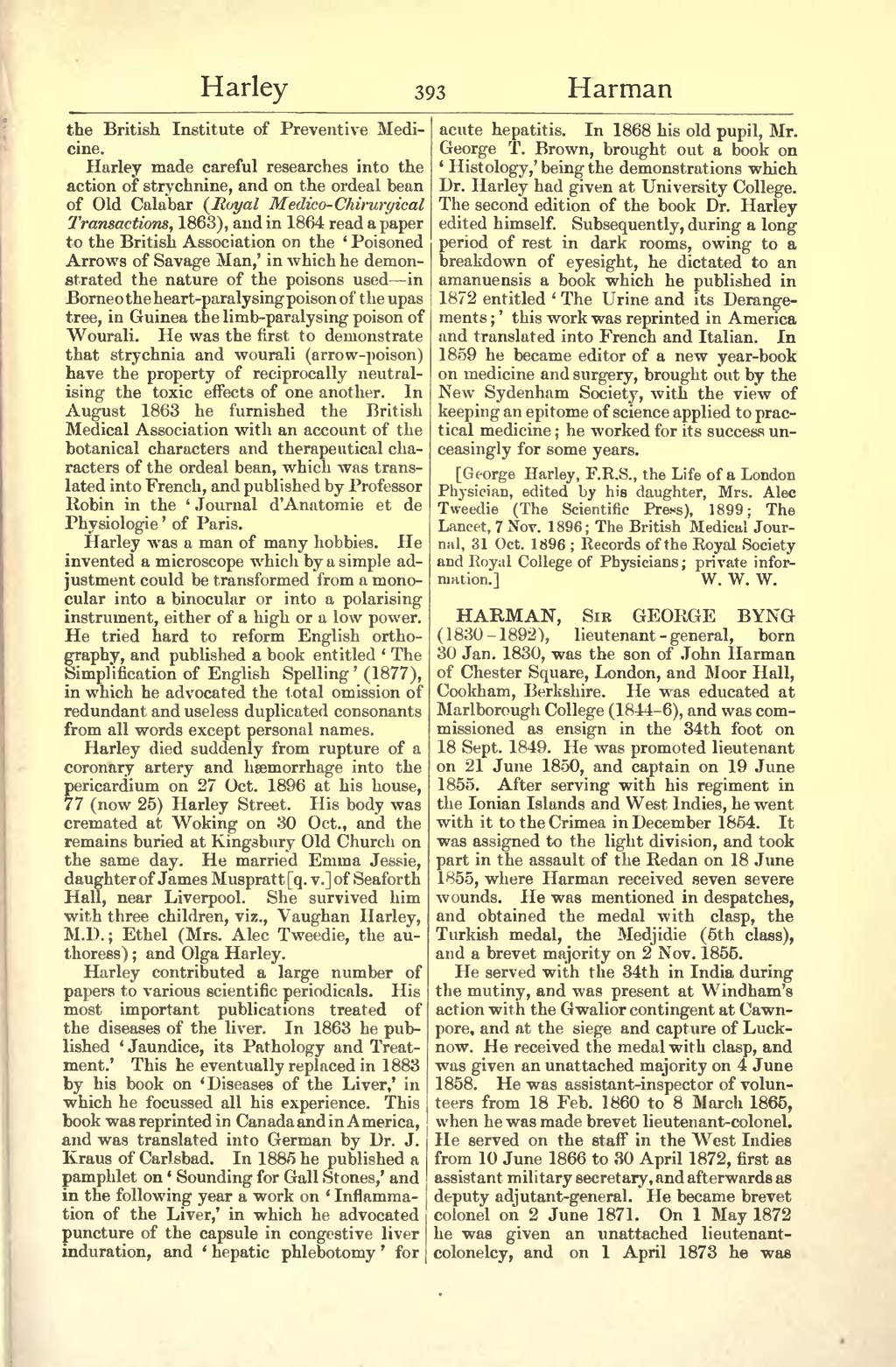the British Institute of Preventive Medicine.
Harley made careful researches into the action of strychnine, and on the ordeal bean of Old Calabar (Royal Medico-Chirurgical Transactions, 1863), and in 1864 read a paper to the British Association on the 'Poisoned Arrows of Savage Man,' in which he demonstrated the nature of the poisons used in Borneo the heart-paralysing poison of the upas tree, in Guinea the limb-paralysing poison of Wourali. He was the first to demonstrate that strychnia and wourali (arrow-poison) have the property of reciprocally neutralising the toxic effects of one another. In August 1863 he furnished the British Medical Association with an account of the botanical characters and therapeutical characters of the ordeal bean, which was translated into French, and published by Professor Robin in the 'Journal d'Anatomie et de Physiologie' of Paris.
Harley was a man of many hobbies. He invented a microscope which by a simple adjustment could be transformed from a monocular into a binocular or into a polarising instrument, either of a high or a low power. He tried hard to reform English orthography, and published a book entitled 'The Simplification of English Spelling' (1877), in which he advocated the total omission of redundant and useless duplicated consonants from all words except personal names.
Harley died suddenly from rupture of a coronary artery and haemorrhage into the pericardium on 27 Oct. 1896 at his house, 77 (now 25) Harley Street. His body was cremated at Woking on 30 Oct., and the remains buried at Kingsbury Old Church on the same day. He married Emma Jessie, daughter of James Muspratt [q. v.] of Seaforth Hall, near Liverpool. She survived him with three children, viz., Vaughan Harley, M.D.; Ethel (Mrs. Alec Tweedie, the authoress); and Olga Harley.
Harley contributed a large number of papers to various scientific periodicals. His most important publications treated of the diseases of the liver. In 1863 he published 'Jaundice, its Pathology and Treatment.' This he eventually replaced in 1883 by his book on 'Diseases of the Liver,' in which he focussed all his experience. This book was reprinted in Canada and in America, and was translated into German by Dr. J. Kraus of Carlsbad. In 1885 he published a pamphlet on 'Sounding for Gall Stones,' and in the following year a work on 'Inflammation of the Liver,' in which he advocated puncture of the capsule in congestive liver induration, and 'hepatic phlebotomy' for acute hepatitis. In 1868 his old pupil, Mr. George T. Brown, brought out a book on 'Histology,' being the demonstrations which Dr. Harley had given at University College. The second edition of the book Dr. Harley edited himself. Subsequently, during a long period of rest in dark rooms, owing to a breakdown of eyesight, he dictated to an amanuensis a book which he published in 1872 entitled 'The Urine and its Derangements;' this work was reprinted in America and translated into French and Italian. In 1859 he became editor of a new year-book on medicine and surgery, brought out by the New Sydenham Society, with the view of keeping an epitome of science applied to practical medicine; he worked for its success unceasingly for some years.
[George Harley, F.R.S., the Life of a London Physician, edited by his daughter, Mrs. Alec Tweedie (The Scientific Press), 1899; The Lancet, 7 Nov. 1896; The British Medical Journal, 31 Oct. 1896; Records of the Royal Society and Royal College of Physicians; private information.]
HARMAN, Sir GEORGE BYNG (1830–1892), lieutenant-general, born 30 Jan. 1830, was the son of John Harman of Chester Square, London, and Moor Hall, Cookham, Berkshire. He was educated at Marlborough College (1844-6), and was commissioned as ensign in the 34th foot on 18 Sept. 1849. He was promoted lieutenant on 21 June 1850, and captain on 19 June 1855. After serving with his regiment in the Ionian Islands and West Indies, he went with it to the Crimea in December 1854. It was assigned to the light division, and took part in the assault of the Redan on 18 June 1855, where Harman received seven severe wounds. He was mentioned in despatches, and obtained the medal with clasp, the Turkish medal, the Medjidie (5th class), and a brevet majority on 2 Nov. 1855.
He served with the 34th in India during the mutiny, and was present at Windham's action with the Gwalior contingent at Cawnpore, and at the siege and capture of Lucknow. He received the medal with clasp, and was given an unattached majority on 4 June 1858. He was assistant-inspector of volunteers from 18 Feb. 1860 to 8 March 1865, when he was made brevet lieutenant-colonel. He served on the staff in the West Indies from 10 June 1866 to 30 April 1872, first as assistant military secretary, and afterwards as deputy adjutant-general. He became brevet colonel on 2 June 1871. On 1 May 1872 he was given an unattached lieutenant-colonelcy, and on 1 April 1873 he was
